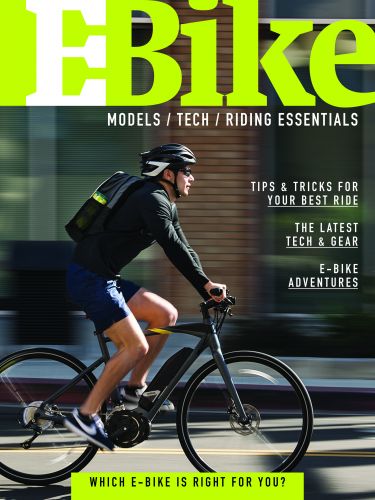Editor's note: The following excerpt from the new VeloPress book, "E-Bike" was written from a consumer's perspective, suggesting questions that a bike should ask an e-bike shopper. We thought BRAIN's retail readers would find it useful or interesting. More information on the book, by Martin Haussermann, is available on the VeloPress website. VeloPress, like BRAIN, is owned by Pocket Outdoor Media.
10 Questions a Bike Shop Should Ask To Help You Find the Right E-Bike
1) What can you tell us about yourself?
Height, weight, occupation, and so forth. Knowing a person's height and inseam is needed to determine an appropriate frame size. Weight is also important because a bicycle's capacity, as set by the manufacturer, cannot be exceeded. For most customers, a bike with a weight capacity of 265 pounds is sufficient, though sometimes a customer requires more. Determining occupation is important not as it relates to income, but whether the customer is active via manual labor or instead sits at a desk.
2) How athletic are you?
That helps us assess a client's fitness level and physiology. Do you exercise regularly, perhaps cycling, running, or walking? In the end, it wouldn't make a lot of sense to encourage a sedentary person to purchase a high-performance road e-bike when the motivation to purchase an e-bike is to improve baseline physical fitness.
3) What's your current bike like?
When customers come into the shop with their current bicycle, it provides a lot of information. Many customers simply want an electrically assisted version of what they already have. In addition, customers can point out what they like about their current bike, what they would change about it, and what kind of problems they have had with it.
4) Why do you want a new bike?
The question of motive is an important part of the assessment. The answer enables you and shop staff to determine the ideal type of bicycle as well as a suitable level of quality. Many customers might say that their neighbor or colleague has purchased an e-bike and that they would like to get something at least as good. But you must choose the bike with the right features for you.
5) How much do you ride your current bike?
The answer establishes an important benchmark, especially with regard to components and price level. Additionally, ask yourself whether you want to continue cycling at your current level or set loftier goals, perhaps to get in better shape or ride stronger and farther than you ever have.
6) How long is your average ride?
With this answer, we can draw conclusions not only regarding bike shape, fit, and ergonomics, but also what capacity a battery should have. For many, a half-hour ride is long enough, while others can ride four hours at a time.
7) What will you use the bicycle for and on what type of terrain?
Identifying your usual terrain and purpose will further guide you in selecting the right type of bike, electric transmission, tires, and drivetrain. Shop staff will know which bikes match your specific interests.
8) How much are you hoping to spend on your e-bike?
You may be wondering why we wait this long to ask this question. It's important to first know the needs of the customer, avoiding the temptation to force a search for the right bike into a price context, since the needs of the customer often don't fit into her or his budget. At this point, it will be pretty clear to shop staff what a bike that meets your needs will cost or what features would need to be sacrificed in order to stay within the original budget. I consider that to be a more honest way of finding a price range than simply presenting the customer with a bike that hits a certain price point but doesn't make the customer happy. Many people are ready to pay more than planned, as long as the end result is positive.
9) Do you have any physical ailments or restrictions that don't have anything to do with riding a bike?
At this point, you'll have already determined the most important physical measurements, such as inseam and frame size, and the staff will have presented one or two well-suited bikes for you. But when you have, say, a shoulder, hip, or knee problem, you can address it in the bike fit . . . for example, by adjusting the saddle, seat post, handlebar, grips, stem, or pedals.
10) Do you currently experience any discomfort while riding a bike?
If your hands go numb while riding or if you find it hard to stay comfortable in a seated position, shop staff can take that into consideration with overall geometry as well as by fine-tuning the position. (And that is why it is helpful to bring your current bike to the store.) Then, longer test rides on the initially selected e-bike become important. This is how you can sort out the right bicycle as well as determine the adjustments that make it suitable for purchase. You might need a saddle, bike stem, or handlebar not offered on the bike but that the shop can easily install, making your e-bike even more custom-fitted to your body and your needs.




